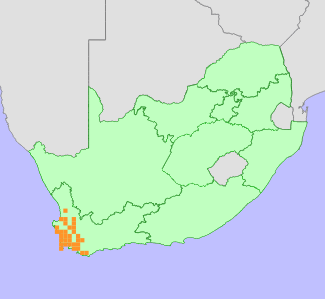|
Scientific Name | Lachnaea grandiflora (L.f.) Baill. |
Higher Classification | Dicotyledons |
Family | THYMELAEACEAE |
Synonyms | Cryptadenia breviflora Meisn., Cryptadenia grandiflora (L.f.) Meisn., Cryptadenia grandiflora (L.f.) Meisn. var. grandiflora, Cryptadenia grandiflora (L.f.) Meisn. var. latifolia Meisn., Passerina grandiflora L.f. |
National Status |
Status and Criteria | Vulnerable A2ac |
Assessment Date | 2023/07/26 |
Assessor(s) | D. Raimondo & N.A. Helme |
Justification | Around 45% of this species' sandy habitat has been lost over the past 100 years to agriculture, urban expansion and severe alien plant invasion. It is a long-lived resprouter (generation length estimated to be 40 years). Furthermore it is probably extinct at over 50% of the 142 sites represented by herbarium records, and most have been lost in the past 120 years. Sampling may have been biased towards the lowland flats and it is likely that lower mountain slopes are not adequately represented in herbaria. Thus the overall loss to the population over the past three generations is suspected to be between 30-50%. |
Distribution |
Endemism | South African endemic |
Provincial distribution | Western Cape |
Range | This species is endemic to the Western Cape province, where it occurs from Swartboskraal in Clanwilliam district to the Cape Peninsula and Bredasdorp. |
Habitat and Ecology |
Major system | Terrestrial |
Major habitats | Graafwater Sandstone Fynbos, Lourensford Alluvium Fynbos, Leipoldtville Sand Fynbos, Hopefield Sand Fynbos, Atlantis Sand Fynbos, Cape Flats Sand Fynbos, Elim Ferricrete Fynbos, Elgin Shale Fynbos, Swartland Alluvium Fynbos, Overberg Sandstone Fynbos, Langebaan Dune Strandveld, Winterhoek Sandstone Fynbos, Piketberg Sandstone Fynbos, Peninsula Sandstone Fynbos, Swartland Alluvium Renosterveld, Swartland Silcrete Renosterveld, Swartland Shale Renosterveld, Saldanha Flats Strandveld, Kogelberg Sandstone Fynbos |
Description | Plants grow in sandy flats and sandy areas on lower mountain slopes. |
Threats |
| Most of the sandy flats subpopulations have disappeared to alien invasive species, urban development and crop cultivation. 45% of this species habitat has been lost over the past 100 years. It is also threatened by agriculture, especially vines (N.A. Helme, 2006). |
Population |
Population trend | Decreasing |
Conservation |
| It is conserved in Cape of Good Hope Nature Reserve and Kammanassie. |
Assessment History |
Taxon assessed |
Status and Criteria |
Citation/Red List version | | Lachnaea grandiflora (L.f.) Baill. | VU A2ac | Raimondo et al. (2009) | | Lachnaea grandiflora (L.f.) Baill. | VU A1c | Victor (2002) | | Lachnaea grandiflora (L.f.) Baill. | Extinct | Hilton-Taylor (1996) | |
Bibliography |
Beyers, J.B.P. 2001. The Cape genus Lachnaea (Thymeleaceae): a monograph. Strelitzia 11:1-115. National Botanical Institute, Pretora.
Goldblatt, P. and Manning, J.C. 2000. Cape Plants: A conspectus of the Cape Flora of South Africa. Strelitzia 9. National Botanical Institute, Cape Town.
Hilton-Taylor, C. 1996. Red data list of southern African plants. Strelitzia 4. South African National Botanical Institute, Pretoria.
Raimondo, D., von Staden, L., Foden, W., Victor, J.E., Helme, N.A., Turner, R.C., Kamundi, D.A. and Manyama, P.A. 2009. Red List of South African Plants. Strelitzia 25. South African National Biodiversity Institute, Pretoria.
Victor, J.E. 2002. South Africa. In: J.S. Golding (ed), Southern African plant Red Data Lists. Southern African Botanical Diversity Network Report 14 (pp. 93-120), SABONET, Pretoria.
|
Citation |
| Raimondo, D. & Helme, N.A. 2023. Lachnaea grandiflora (L.f.) Baill. National Assessment: Red List of South African Plants version 2024.1. Accessed on 2025/10/31 |
 Comment on this assessment
Comment on this assessment


